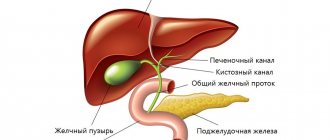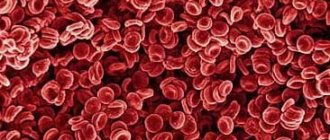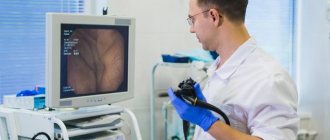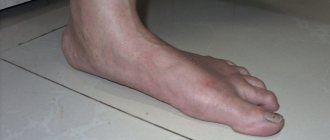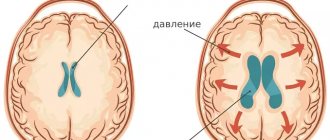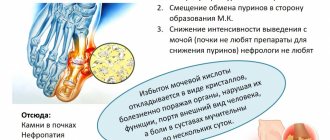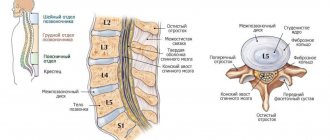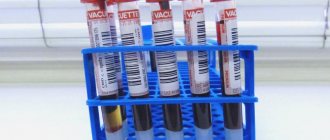Biliary dyskinesia
Among the many causes of abdominal pain, dyskinetic biliary tract disorders (BBD) stand out. This is one of the most popular diagnoses among therapists in clinics - and at the same time, many cases of ADHD remain undiagnosed. What is the difficulty and how to make a diagnosis?
Bile activity: norm and disorders
Bile (a thick, bitter liquid produced by liver cells) is actually one of our digestive juices. It takes part in the intestinal phase of digestion, helping to break down fats.
In addition, it inactivates pepsin, “brought” by semi-digested food from the stomach, otherwise it reduces the activity of pancreatic enzymes necessary for further digestion. Produced in the liver, bile enters the gallbladder through the hepatic duct system - there it accumulates and “ripens”, becoming more concentrated.
Read also: Diet for gallstone disease
As soon as a portion of food from the stomach enters the duodenum, cystic bile is “added” to it through the common bile duct. The hepatic bile ducts, gallbladder, common bile duct and the circular sphincter muscles that separate them together make up the bile ducts.
When the coordinated work of these structures is disrupted, a condition called dyskinesia occurs (“dis” - disorder, “kinesio” - movement). Today, there are two main variants of JVP.
Hyperkinetic variant: stress and acute pain
With hyperkinetic GIB, bile, especially not remaining in the bladder, enters the intestine at an accelerated pace, and not on “demand”. In this case, firstly, the efficiency of digestion decreases, since immature bile that has not settled in the gallbladder has low chemical activity. Secondly, there is an increased and almost continuous contraction of the muscles of the ductal system.
Disorders in the movement of bile are usually provoked by fatty foods and - this is important! - stress. The muscles of the biliary tract are controlled by the autonomic nervous system. When its sympathetic (adrenaline, “stress”) part is activated, muscle contractions intensify and accelerate.
The patient experiences sharp stabbing pain in the right hypochondrium. Inadequate digestion leads to stool disturbances and lack of nutrients. However, the general condition deteriorates little, the patients do not lose their ability to work and vital activity and are not very inclined to a thoughtful diagnostic search.
Hypokinetic option: immobility and long-term pain
Here everything is exactly the opposite: bile is released slowly, remains in the gallbladder for a long time, and its concentration increases more than necessary. The bile ducts seem to be “lazy” to deliver bile to the intestines. Actually, one of the main reasons for this type of ADHD is a sedentary lifestyle.
The pain syndrome with this option looks different: the pain is dull, aching, “spread out” - that is, it can spread throughout the entire abdomen. In some cases, there may be no actual pain, but discomfort is manifested by a feeling of fullness, distension in the right hypochondrium.
The duration of unpleasant sensations reaches several hours (whereas with the hyperkinetic version - usually no more than half an hour). Here, patients are already seriously thinking about solving the problem and finally decide to visit a doctor to get a diagnosis.
How to make a diagnosis
It must be said that with moderately severe JVP, the clinic—that is, the patient’s complaints—is not very specific. Pain and heaviness in the abdomen, transient stool disorders can accompany many other diseases, not always even related to the gastrointestinal tract! However, to confirm the diagnosis in this case, there is an available technique - ultrasound with functional tests.
One of the most common causes of gallbladder gallstones is a violation of the anatomical structure: a change in the shape of the gallbladder, the presence of septa in it, sometimes even doubling. These changes, which impair the flow of bile, occur in at least 25–30% of people (which is why episodes of pain in the right hypochondrium are familiar to many).
Therefore, signs of VADP can often be detected on an ultrasound by a simple examination, but a special test is needed to study motor skills. First, the gallbladder is measured and examined on an empty stomach, and then the patient is offered a so-called “test breakfast” (usually two raw yolks). After eating breakfast, the bladder is measured again at certain intervals, monitoring the change in its shape and volume.
An x-ray examination is performed in a similar way, but it requires special preparation. Bile needs contrast, so first the patient takes special tablets (or receives an intravenous injection). But the probe method is practically not used today - it is very uncomfortable for the patient.
***
What can you do to avoid getting caught by doctors for all this complicated diagnostics? Methods for preventing ADHD are quite simple. You need regular physical activity, a healthy diet, a proper daily routine and, of course, you should take care of your nerves to prevent hyperkinetic dyskinesia.
Lidiya Kulikova
Photo istockphoto.com
Gallbladder diseases
The patient's first visit to the doctor about biliary colic does not mean that he has an acute process. Almost always, a thorough examination reveals signs of chronic suffering of this organ. In other words, cholecystitis develops gradually and therefore an acute attack of cholecystitis is an exacerbation of a chronic, latent disease of the gallbladder.
In chronic cholecystitis, the most common symptoms are indications of pain in the right hypochondrium, bitterness in the mouth, poor appetite, nausea, and sometimes vomiting bile in the morning.
Exacerbation of the disease is accompanied by attacks of unbearable cutting pain in the right hypochondrium or in the epigastric region. The pain has a typical irradiation (direction) - up, to the right and behind - to the area of the right shoulder blade, to the right shoulder, to the right half of the neck, sometimes spreads throughout the abdomen, intensifies with a deep breath, in a position on the left side. The pain syndrome may be accompanied by nausea and repeated vomiting mixed with bile, which does not bring relief. Pallor and yellowness of the skin are noted. The tongue is coated with a yellow-brown coating and is rather dry. The mobility of the abdominal wall in the upper part on the right is limited. Here, an area of increased skin sensitivity, pain on palpation (pressure), and sometimes a symptom of muscle protection are determined.
It must be emphasized that the localization of pain in the right half of the chest, the right shoulder blade is as characteristic of diseases of the gallbladder as pain behind the sternum and in the left arm is characteristic of coronary heart disease. It is important to find out the immediate, provoking cause of the pain syndrome. An attack of cholecystitis is most often associated with the abuse of fatty foods and other eating errors. A relapse of an attack is most often caused by a stressful situation, nervous tension, or mental trauma. In persons suffering from cholelithiasis, pericholecystitis, an attack more often occurs due to physical stress, horse riding, cycling, or driving a car on bumpy roads.
Transient jaundice that develops after an attack is characteristic of cholelithiasis, but can also occur with hypermotor dyskinesia. In some cases, when the outflow of bile is impaired, patients note the appearance of discolored feces (white-gray) within 1-2 days.
With uncomplicated cholelithiasis, an attack of pain begins suddenly and just as suddenly stops; the patient feels quite satisfactory the very next day.
More often, chronic diseases of the biliary tract occur with so-called minor symptoms - general malaise, low-grade fever, mild dyspeptic symptoms, pain or discomfort from the heart. Such patients spend a long time, but unsuccessfully, visiting doctors of various specialties, who sometimes mistakenly diagnose rheumatism, thyrotoxicosis, neurocirculatory dystonia, peptic ulcer, gastritis, neuralgia, etc., while the cause of all these symptoms lies in latent cholecystitis, dyskinesia or cholelithiasis. It may be the other way around, the patient is being treated for various diseases of the gallbladder, but in fact the true cause is duodenal ulcer.
In elderly and senile people, a painless course of cholecystitis occurs, which is associated with a change in the threshold of pain sensitivity and unresponsiveness of the body in old age.
In patients with chronic diseases of the biliary tract, the stomach may be involved in the process, and belching, bitter taste in the mouth, heartburn, nausea, and anacidity are often noted. Possible bowel problems (diarrhea, constipation). All these disorders affect the state of the central nervous system; patients become nervous, irritable, and suffer from insomnia. And, conversely, people suffering from chronic diseases of internal organs may develop dyskinesia of the gallbladder.
Hypotonic (atonic) dyskinesia is usually characterized by weak, dull pain (a feeling of heaviness) in the right hypochondrium. The pain is usually accompanied by nausea when eating, an unpleasant taste in the mouth, and poor tolerance to food odors.
Diagnostic methods for dyskinesia
Using ultrasound of the gallbladder, the shape, size, deformation of the gallbladder, the condition of the ducts, and the presence of stones are assessed.
Duodenal intubation in children with biliary dyskinesia allows one to assess the volume of bile portions, its microscopic and biochemical composition. When examining duodenal contents, signs of inflammation, a tendency to form stones, lamblia, etc. can be detected.
Timely diagnosis and adequate treatment of dyskinesia, taking into account its type, makes it possible to normalize the processes of bile drainage and digestion, prevent inflammation and early stone formation in the biliary tract in children. Long-term disruption of the biliary system can lead to the development of cholecystitis, cholangitis, cholelithiasis, and intestinal dysbiosis.
The results of a blood test also indicate the presence of an inflammatory process in the body. In such cases, the child often needs to be hospitalized in order to undergo an examination and prescribe the correct treatment.
Symptoms
Symptoms of hyperkinetic dyskinesia:
- Intense paroxysmal pain in the right hypochondrium, sometimes radiating to the right shoulder and scapula. Pain appears due to errors in diet, physical activity, and stressful situations.
- Nausea, less often vomiting. The painful attack is more pronounced when this form is combined with sphincter hypertension.
Symptoms of hypokinetic dyskinesia:
- Constant, mild pain in the right hypochondrium, accompanied by a feeling of fullness, heaviness in the abdomen, nausea, a bitter taste in the mouth, and loss of appetite.
- Bowel problems (constipation or diarrhea).
- Sometimes the color of stool changes: it becomes light.
- The danger of gallbladder hypokinesia lies in the fact that when bile stagnates, the absorption of liquid and water-soluble substances increases, the concentration of cholesterol and bilirubin in the bile increases, which contributes to the formation of clots, and subsequently stones in the gall bladder.
Functional disorders of the biliary system in children
Biliary dyskinesia is a classic representative of functional disorders (diseases) of the gastrointestinal tract. The modern definition, according to DA Drossman, is that “functional impairment is a varied combination of gastrointestinal symptoms without structural or biochemical abnormalities.” Functional diseases include conditions in which it is not possible to detect morphological, genetic, metabolic and other changes in organs. Functional pathological syndromes arise as a result of violations of the mechanisms regulating the functions of a particular organ or system. Disorder of the motor-tonic function of the biliary tract - or dyskinesia of the biliary system - is one of the most common diseases in childhood. Violation of the outflow of bile or its irregular flow into the intestinal lumen affects not only the functioning of the digestive tract, but also the entire organism as a whole, since bile, being a multicomponent biochemical substrate, provides a number of functional processes. These include the following: neutralization of hydrochloric acid and pepsin, emulsification of fats and thereby participation in their hydrolysis, activation of intestinal and pancreatic enzymes, enhanced absorption of fat-soluble vitamins A, D, K, E, fixation of enzymes on villi, support of peristalsis and intestinal tone, antibacterial and antiprotozoal action; metabolites of xenobiotics, medicinal and toxic substances are excreted into the intestinal lumen with bile.
The structure of the biliary system consists of the right and left hepatic ducts, the common hepatic duct, the gallbladder (GB), the cystic duct, and the common bile duct. The common bile duct opens into the duodenum along with the main pancreatic duct through the large duodenal (Vater) nipple protruding into its lumen, in the thickness of which there is a true anatomical sphincter - the sphincter of Oddi, which regulates the flow of bile and pancreatic secretions into the intestine. The sphincter of Oddi consists of the sphincter of the major duodenal papilla, the sphincter of the common bile duct and the sphincter of the pancreatic duct. In rare cases, these sphincters open separately into the lumen of the duodenum. In addition to the anatomical one, there are two functional sphincters in the biliary system - the sphincter of Miritsi (at the confluence of the right and left hepatic ducts) and Lütkens (at the junction of the neck of the gallbladder into the cystic duct). The main task of the sphincter apparatus is to regulate the flow of bile into the intestine and prevent reflux. The biliary system has a layered structure common to the entire gastrointestinal tract, including the mucous and submucosal membranes, a muscular layer of longitudinal and circular fibers and a loose outer connective tissue membrane in which vessels and nerves are located. In addition to ensuring the passage of bile, the biliary tract takes part in the formation of the final composition of bile, since the mucous membrane is responsible for the processes of absorption and secretion of water, chlorides, bicarbonates, etc.
Regulation of the biliary system is coordinated and controlled by the autonomic nervous system (plexus hepaticus, sympathetic and parasympathetic divisions) and neurohumoral factors (cholecystokinin, gastrin, secretin), among which cholecystokinin has the most significant influence. Moderate irritation of the vagus nerve causes coordinated activity of the gallbladder and sphincters, severe irritation causes its spastic contraction. Increasing the tone of the sympathetic link - relaxing the sphincters and reducing the tone of the gallbladder. Looking ahead, it should be noted that the majority of older children, especially with diseases of the upper gastrointestinal tract, are parasympathotonics, which a priori causes a hypertensive type of dysfunction of the biliary system. Normally, the sphincter of Oddi periodically opens and during the interdigestive period, bile flows evenly into the lumen of the duodenum at a rate of 4–5 drops per minute. The most powerful stimulator of gallbladder contraction is food intake. The entry of bile into the duodenum coincides with the time of passage of the peristaltic wave through the pylorus. When food enters the duodenum, a regulatory peptide, cholecystokinin, is produced, which regulates further contraction of the gallbladder. The time of tonic contraction of the gastrointestinal tract depends on the volume and quality of the food taken - with a large meal, especially fatty food, the contraction of the gastrointestinal tract lasts until the stomach is completely emptied. When eating a small amount of food, especially with a low fat content, the reduction in gallbladder is short-term. This pattern of GB reduction must be taken into account when constructing functional tests and only adequate choleretic breakfasts should be used. Of the nutrients, egg yolks cause the maximum reduction in GB - up to 80%. After contraction, the tone of the gallbladder decreases and a period of filling it with bile begins.
Reasons for the development of functional disorders of the biliary tract . The causes of functional disorders are usually associated with a dysregulation of the organ whose function is impaired. These changes in nervous regulation are usually provoked by psycho-emotional and stress factors and are caused by autonomic disorders or organic damage to the central nervous system with the subsequent development of autonomic dysfunction. In children of the first year of life, functional disorders of the gastrointestinal tract are most often a manifestation of perinatal lesions of the central nervous system in the structure of vegetative-visceral syndrome or natal trauma to the spinal parts of the nervous system. At older ages, the role of reflex and neurohumoral disorders in the development of chronic diseases of the gastrointestinal tract increases. The development of motor-tonic disorders of the biliary tract is caused by autonomic disorders, neuroses, psycho-emotional disorders, food allergies, parasitosis and chronic diseases of the digestive system, eating disorders, physical inactivity, smoking, alcohol and much more.
Terminology and classification . In Russian medical literature, the term “biliary dyskinesia” (BDSD) is widely used and familiar. In foreign medical practice, it corresponds to the concept of “dysfunctional disorders of the biliary tract.” There are many definitions of JVP. The most complete definition of dyskinetic disorders of the biliary tract can be considered the definition proposed by domestic gastroenterologists Academician A.L. Grebenev and Professor A.A. Sheptulin in 1997: “DZHVP is a disorder of the motor-tonic function of the biliary system, which is based on uncoordinated (excessive or insufficient) contraction of the gallbladder, sphincters of Oddi, Lütkens, Miritsi, due to disruption of the interaction of the innervation and paracrine systems, coordinating the sequence of their contraction and relaxation.” ICD 10 distinguishes two forms - dyskinesia of the gallbladder and cystic duct (K 82.8) and spasm of the sphincter of Oddi (K 83.4). According to the Rome Consensus III (Los Angeles, 2006), the following forms of dyskinetic disorders are distinguished: E1 - functional disorders of the gastrointestinal tract, E2 - functional biliary disorder of the sphincter of Oddi, E3 - functional pancreatic disorder of the sphincter of Oddi. Disturbance of synchronicity in the work of the gastrointestinal tract and the sphincter apparatus is the cause of the formation of clinical symptoms.
Clinical manifestations . For patients with ADHD, typical complaints are stabbing pain in the right side or hypochondrium after fatty, fried foods or during physical or emotional stress. Such symptoms are caused by a spastic state of the sphincter of Oddi or excessive contractions of the muscular layer of the gallbladder. When the gallbladder is overstretched (with hypotension or impaired bile outflow due to severe spasm of the sphincters), complaints of a feeling of heaviness and/or fullness in the right side or hypochondrium appear. If you eat fatty or fried foods, you may experience nausea or vomiting.
During an objective examination, one can note pain on palpation in the right hypochondrium, positive cystic symptoms, including a positive frenicus symptom on the right.
Diagnostics. From studies of the clinical minimum, only in the coprogram can signs of impaired bile secretion be noted - neutral fat, fatty acids, soaps. In the biochemical spectrum of blood, an increase in the level of alkaline phosphatase can be noted. According to the Rome Consensus criteria, pancreatic dysfunction of the sphincter of Oddi is characterized by increased levels of lipase and amylase in the blood. Duodenal intubation is rarely used in clinical practice today. The most common and accessible method for studying the condition of the biliary tract is ultrasound diagnostics. Ultrasound examination of the gallbladder is performed on an empty stomach. Normally, the gallbladder has a round, oval or pear-shaped shape. The thickness of the wall of the gallbladder can normally vary from 0 to 4 mm; when describing the wall, the uniformity of its structure is important. The lumen of the bladder is echo-negative. The size of the gallbladder is variable and depends little on age. In our observations, the length of the gallbladder was 7 cm in a newborn and 4 cm in an adolescent. The average length of the gallbladder during ultrasound examination is 5–7 cm, width 1.2–2.5 cm. It must be remembered that the ultrasound dimensions of the bladder do not correspond to its true anatomical dimensions and is categorically incorrect based only on an increase in the ultrasound dimensions without performing a functional research to establish a diagnosis of hypomotor dysfunction of the gallbladder!
A common finding with GIB on ultrasound is the location of thick, heterogeneous bile in the lumen of the GB, which indicates its stagnant changes.
Since the introduction of ultrasound examination into clinical practice, the detection of anomalies in the shape of the gallbladder (kinks) has sharply increased.
It must be remembered that most of the identified kinks are functional (when examined in a standing position, they straighten out) and are associated with the intensive growth of the gallbladder and the small capacity of its bed. As the child grows, such kinks can appear and disappear repeatedly and sometimes take on the most bizarre forms. It is a mistake to make a diagnosis of bile ducts only on the basis of identifying functional kinks, since they rarely impede bile flow, although they can be attributed to predisposing factors.
A functional study of the contractility of the gallbladder (echocholecystography) is best carried out using the method proposed at the Research Institute of Pediatrics in 1987. According to this technique, the size of the gallbladder is taken on an empty stomach and every 15 minutes after taking a choleretic breakfast for 90 minutes. The optimal breakfast is raw yolks or xylitol (5 g/20 kg of weight). The use of other breakfasts (bread and butter, yogurt, sour cream, cheese, chocolate) causes either a weak or delayed contraction of the gallbladder, which leads to an erroneous diagnosis of hypomotor dyskinesia. With normal contraction of the gallbladder, its volume is reduced by approximately 50% 30–60 minutes after taking a choleretic breakfast, then its recovery is noted. Control determination of the size of the gallbladder only an hour after the start of the study (without intermediate measurements) again leads to an erroneous diagnosis of hypomotor dysfunction due to the fact that after 1 hour in many children the volume is restored (
), and the researchers conclude that the motor function of the gallbladder is reduced.
In children with symptoms of GIB on the background of a chronic disease of the gastrointestinal tract, a normokinetic or hyperkinetic variant of GB contraction is more often observed ().
We conducted a study of the contractile function of the gallbladder in children with neurological abnormalities (consequences of perinatal lesions of the central nervous system). The results of the study of the contractile function of the gallbladder in children with consequences of perinatal lesions of the central nervous system revealed such an individual and chaotic kinetic profile of contraction that in these patients it was impossible to talk about normo- or hyperkinesis of the gallbladder, and therefore it was not possible to draw a conclusion about the type of dysfunction. That is why it is more correct in these cases to talk about an uncoordinated contraction of the gallbladder, which in turn is caused by dysfunction of the autonomic nervous system against the background of the consequences of perinatal lesions of the central nervous system. It should immediately be noted that the total reduction in the volume of the gallbladder was 50–95%, which excludes the hypotonic variant of dysfunction.
Other research methods, such as retrograde cholangiopancreatography and biliary tract scintigraphy, are rarely used in domestic medical practice.
Treatment of functional disorders of the biliary system . First of all, when treating any disease, it is necessary to pay attention to optimizing lifestyle and neutralizing the effects of predisposing and damaging factors. Thus, it is recommended to normalize the duration of night sleep, since it is during sleep that regulatory processes on the part of the central nervous system are restored. The physiological duration of night sleep in adolescence is 8 hours a day, in younger schoolchildren it is 9–10 hours. In case of severe asthenic syndrome, additional daytime sleep is recommended. Sufficient daily physical activity and walking are a preventive and therapeutic component in the management of patients with ADHD. Electromagnetic radiation has a significant damaging effect on the central nervous and autonomic systems, and therefore it is necessary to limit the time watching TV shows and working at the computer to 2–3 hours a day. As for the nutritional factor, in case of pathology of the biliary system, diet No. 5 is recommended. Since the very fact of eating is a good stimulator for the flow of bile into the duodenum, meals should be regular, not plentiful, 4-5 times a day. Mechanical and chemical sparing is recommended; food is steamed or boiled. Recommended: vegetable and fruit salads, vinaigrettes, soft-boiled eggs, cheese, cottage cheese, boiled or baked meat and fish, vegetarian soups, dairy and fermented milk products, juices. It is allowed to add vegetable oils to salads in small quantities at each meal. Dishes with a high content of extractive substances (strong meat, fish, mushroom broths, spices, marinades, smoked meats) are excluded, and refractory fats - lard, pork - are limited. Carbonated drinks and cold drinks and dishes are excluded (they contribute to spasm of the bile ducts).
Drug therapy . Drug treatment for dysfunctional diseases of the biliary tract depends on the form of dysfunction and the nature of the underlying disease and must be comprehensive. Considering the large role of disorders of the autonomic and central nervous systems in the development of biliary disorders, it is necessary to use means aimed at restoring impaired regulation; treatment of diseases against which the dyskinetic process has developed is carried out.
In the hypertensive form of dysfunction, antispasmodics are prescribed to relieve pain: No-shpa, Papaverine hydrochloride, Dibazol, etc. The drugs are prescribed in age-specific doses, in a short course of 3–5 days, since they all have a systemic antispasmodic effect. The peripheral antispasmodic mebeverine (Duspatalin) is widely used in clinical practice today. Duspatalin is prescribed 20 minutes before meals, 1 capsule 2 times a day, and can be used long-term (approved for use in children over 12 years of age). After pain relief, further therapy is selected. As a rule, modern drugs used to correct biliary tract dysfunction have a combined effect: mild antispasmodic, choleretic and cholekinetic, hepatoprotective, which makes it possible to individualize the therapy. Below are characteristics of some recommended drugs.
Olimethine. Herbal preparation (oil of calamus, mint, olive, turpentine, sulfur), release form - capsules. It has antispasmodic, choleretic, anti-inflammatory, diuretic effects. Take 1-2 capsules daily before meals.
Holasas. Condensed aqueous extract of rose hips. Release form: syrup. Has a choleretic effect. Prescribed 1/2–1 teaspoon before meals.
Holagol. A combined drug (turmeric, buckthorn, olive oil, magnesium salicylate) has anti-inflammatory and choleretic effects. Release form: drops. Apply 1-5 drops per piece of sugar or bread 30 minutes before meals.
Gepabene. The combined drug (fumitive, milk thistle) has choleretic, cholekinetic and hepatoprotective effects. Release form: capsules (approved for use in children over 6 years of age). Take 1-2 capsules with meals.
Odeston. The active ingredient is hymecromone. It has a peripheral selective antispasmodic and choleretic effect. Release form: tablets. Taken 30 minutes before meals.
LIV-52. A complex preparation of plant origin (prickly capers, chicory, black nightshade, senna, terminalia, yarrow, Tamarix galii), has a wide spectrum of activity, providing anti-inflammatory, choleretic, hepatoprotective and antispasmodic effects. Release form: drops and tablets. Approved for use in children from 2 years of age. Prescribed 10–15 minutes before meals.
Hofitol. A preparation based on field artichoke. Has a systemic complex effect; hepatoprotector of plant origin, increases the outflow of bile, reduces intrahepatic cholestasis, has a mild diuretic effect, reduces the content of nitrogenous substances in the blood, exhibits antioxidant activity, improves the antitoxic function of the liver, in addition, reduces the synthesis of cholesterol by hepatocytes, normalizes intracellular phospholipid metabolism, reduces atherogenic cholesterol fractions , normalizes lipid profile parameters. Approved for use in children from the first days of life. It has the following forms of release: solution (with low volume alcohol content), tablets and solution for injection in ampoules. Taken before meals.
Galstena. Complex homeopathic medicine (milk thistle, dandelion, celandine, Na sulfate, phosphorus). It has anti-inflammatory choleretic and hepatoprotective effects. Release form: drops. Approved for use in young children. Prescribed 30 minutes before meals.
Hepel. Complex homeopathic medicine. It has anti-inflammatory, choleretic and hepatoprotective effects, normalizes the processes of autonomic regulation of the biliary system. Release form: tablets. Prescribed sublingually 30 minutes before meals.
It should be noted that the market of drugs, including choleretic drugs, is replenished every year. As mentioned earlier, to optimize treatment it is necessary to take into account the spectrum of action of the drug and the characteristics of the course of the disease in the patient. If bile thickening syndrome, metabolic disorders are detected, or crystalline changes in the structure of bile are detected (according to ultrasound), it is necessary to choose a drug that has a hepatoprotective effect, or prescribe separate courses of hepatoprotective therapy. The average course of drug treatment for biliary dysfunction is 2–3 weeks. Then, to consolidate the effect, herbal medicine can be recommended. The choice of herbs that have a choleretic effect is quite wide: calamus, artichoke, common barberry, sandy immortelle, dandelion, peppermint, cudweed, corn silk, sage, etc. The average course of herbal medicine is 1 month, you can use medicinal herbal tea Tubages have a good drainage effect; it should be noted that tubages are prescribed only after the spastic state of the sphincters has been relieved, respectively, at the second or third stage of treatment. Tubage technique (according to Demyanov): in the morning on an empty stomach the patient is given a “choleretic breakfast” to drink, which can be 15–20 ml of a 33% warm solution of magnesium sulfate, or 2 egg yolks, or warm olive (corn oil), or 100–200 ml 10% solution of sorbitol, xylitol, warm mineral water (3 ml/kg body weight); then you need to lay him on his right side on a warm heating pad for 1.5–2 hours, during the procedure to open the sphincter of Oddi, take 2–3 deep breaths every 5 minutes. It is recommended to carry out 1–2 procedures per week, a course of 8–10 procedures.
Physiotherapy . Methods are used aimed at normalizing the activity of the central nervous system and autonomic nervous system; photochromotherapy or electrophoresis with Ca and Br according to Shcherbak on the collar zone, transair, EHF puncture on the projection area of the 7th cervical vertebra. Locally - electrophoresis with a 5% solution of magnesium sulfate, paraffin or ozokerite applications, inductothermy to the right hypochondrium, course of 8-10 procedures.
Clinical examination. The nature and volume of dispensary activities carried out are determined by the structure of the existing pathology.
V. A. Aleksandrova , Doctor of Medical Sciences, Professor S. V. Rychkova , Candidate of Medical Sciences, Associate Professor of St. Petersburg MAPO , St. Petersburg
